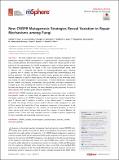| dc.contributor.author | Vyas, Valmik K. | |
| dc.contributor.author | Bushkin, G. Guy | |
| dc.contributor.author | Bernstein, Douglas A. | |
| dc.contributor.author | Sewastianik, Magdalena | |
| dc.contributor.author | Barrasa, M. Inmaculada | |
| dc.contributor.author | Getz, Matthew Aaron | |
| dc.contributor.author | Bartel, David | |
| dc.contributor.author | Fink, Gerald R | |
| dc.date.accessioned | 2018-06-19T18:11:34Z | |
| dc.date.available | 2018-06-19T18:11:34Z | |
| dc.date.issued | 2018-04 | |
| dc.date.submitted | 2018-03 | |
| dc.identifier.issn | 2379-5042 | |
| dc.identifier.uri | http://hdl.handle.net/1721.1/116421 | |
| dc.description.abstract | We have created new vectors for clustered regularly interspaced short palindromic repeat (CRISPR) mutagenesis in Candida albicans, Saccharomyces cerevisiae, Candida glabrata, and Naumovozyma castellii These new vectors permit a comparison of the requirements for CRISPR mutagenesis in each of these species and reveal different dependencies for repair of the Cas9 double-stranded break. Both C. albicans and S. cerevisiae rely heavily on homology-directed repair, whereas C. glabrata and N. castellii use both homology-directed and nonhomologous end-joining pathways. The high efficiency of these vectors permits the creation of unmarked deletions in each of these species and the recycling of the dominant selection marker for serial mutagenesis in prototrophs. A further refinement, represented by the "Unified" Solo vectors, incorporates Cas9, guide RNA, and repair template into a single vector, thus enabling the creation of vector libraries for pooled screens. To facilitate the design of such libraries, we have identified guide sequences for each of these species with updated guide selection algorithms.IMPORTANCE CRISPR-mediated genome engineering technologies have revolutionized genetic studies in a wide range of organisms. Here we describe new vectors and guide sequences for CRISPR mutagenesis in the important human fungal pathogens C. albicans and C. glabrata, as well as in the related yeasts S. cerevisiae and N. castellii The design of these vectors enables efficient serial mutagenesis in each of these species by leaving few, if any, exogenous sequences in the genome. In addition, we describe strategies for the creation of unmarked deletions in each of these species and vector designs that permit the creation of vector libraries for pooled screens. These tools and strategies promise to advance genetic engineering of these medically and industrially important species. | en_US |
| dc.description.sponsorship | National Institutes of Health (U.S.) (Grant GM035010) | en_US |
| dc.description.sponsorship | National Institutes of Health (U.S.) (Grant GM118135) | en_US |
| dc.description.sponsorship | National Institutes of Health (U.S.) (Grant R15AI130950) | en_US |
| dc.publisher | American Society for Microbiology | en_US |
| dc.relation.isversionof | http://dx.doi.org/10.1128/mSphere.00154-18 | en_US |
| dc.rights | Creative Commons Attribution 4.0 International License | en_US |
| dc.rights.uri | http://creativecommons.org/licenses/by/4.0/ | en_US |
| dc.source | American Society for Microbiology | en_US |
| dc.title | New CRISPR Mutagenesis Strategies Reveal Variation in Repair Mechanisms among Fungi | en_US |
| dc.type | Article | en_US |
| dc.identifier.citation | Vyas, Valmik K. et al. “New CRISPR Mutagenesis Strategies Reveal Variation in Repair Mechanisms Among Fungi.” Edited by Aaron P. Mitchell. mSphere 3, 2 (April 2018): e00154–18 © 2018 Vyas et al | en_US |
| dc.contributor.department | Massachusetts Institute of Technology. Department of Biology | en_US |
| dc.contributor.mitauthor | Getz, Matthew Aaron | |
| dc.contributor.mitauthor | Bartel, David | |
| dc.contributor.mitauthor | Fink, Gerald R | |
| dc.relation.journal | mSphere | en_US |
| dc.eprint.version | Final published version | en_US |
| dc.type.uri | http://purl.org/eprint/type/JournalArticle | en_US |
| eprint.status | http://purl.org/eprint/status/PeerReviewed | en_US |
| dc.date.updated | 2018-06-15T18:44:43Z | |
| dspace.orderedauthors | Vyas, Valmik K.; Bushkin, G. Guy; Bernstein, Douglas A.; Getz, Matthew A.; Sewastianik, Magdalena; Barrasa, M. Inmaculada; Bartel, David P.; Fink, Gerald R. | en_US |
| dspace.embargo.terms | N | en_US |
| dc.identifier.orcid | https://orcid.org/0000-0002-4172-2187 | |
| dc.identifier.orcid | https://orcid.org/0000-0002-3872-2856 | |
| dc.identifier.orcid | https://orcid.org/0000-0003-3704-2899 | |
| mit.license | PUBLISHER_CC | en_US |
